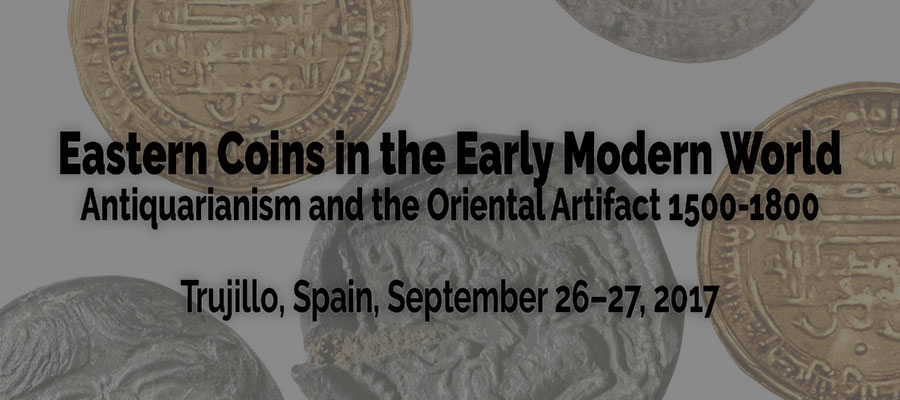Eastern Coins in the Early Modern World: Antiquarianism and the Oriental Artifact 1500-1800, Trujillo, Spain, September 26–27, 2017
From the 15th to the 18th century, collecting, studying antique coins and exchanging them as gifts was an antiquarian interest and a social pattern among scholars and learned individuals, even princes. Numismatics was regarded as a comparatively inexpensive approach for the reconstruction of history and as a token of memory of the vanished glory of antiquity, its history, its customs, and its institutions. The centers of imagination were almost invariably Rome and Greece, the worlds of the two classical languages. But in the course of the re-discovery of Oriental languages (Hebrew, Aramaic, Coptic and Arabic and some more), erudite individuals turned also their attention to the Oriental artefacts and as the most accessible of all, coins.
Some of them even published short articles on coins and commenting them such as Johann Heinrich Hottinger De nummis orientalium (1659), Hermann Conring Paradoxa de nummis Hebraeorum (1675), Otto Sperling De nummis non cusis (1700), Jakob Rhenferd Periculum Phoenicium (1706), and Adrian Reland De nummis Hebraeorum (1709). The first monograph, even scholarly in the modern sense, was authored and illustrated by Georg Jakob Kehr Monarchiae Asiatico-Saracenicae Status (1724). He described a hoard of Kufic Dirhams with almost accurate descriptions and its provenance from the vicinity of Gdansk. This monographs stands even at the beginning of Islamic archaeology. In Spain Bernardo Aldrete studied already in 1614 in Varias antiguedades de España, Africa y otras prouincias Punic coins. But Vincenzio Juan de Lastanosa’s Museu de las medallas desconoçidas Espannolas (1645) was the first witness of this antiquarian curiosity in Islamic coins. Recent studies showed that in order to go further back to the origins of early modern interest in Oriental artefacts and coins in particular, we have to go beyond the printed matter and step down into archives and study manuscripts and letters.
Based on recent scholarship on early modern antiquarianism and the genesis Oriental philologies in the 17th century, we intend to yield new insights into the rise of antiquarianism with respect to Oriental objects and to consider the different scholarly attitudes towards the material culture of the Orient. We invite scholars to examine the extent to which the role of the Biblical-Oriental conceptions shaped the Antiquarian treatment of oriental artefacts? What coins were preferred in the collections and the studies? What were the sources of this intellectual stimulation? What was the impact of commercial travel and pilgrimages to the holy sites in the rise of antiquarianism? The archaeological artefacts, the trade networks, pilgrimages, however, existed before since the Middle Ages, but rare kindled intellectual interest. What changed?
The conference will address four key themes:
- The material sources: Oriental coins and objects as part of the antiquarian interest in the countries of origin (northern and eastern Europe, Iberia, and Sicily).
- The impact of Oriental material culture in Europe: archives, museums, and collecting.
- Early approaches to Oriental coins: from a biblical understanding to philology.
- Oriental artefacts in the discourse and gift exchanging of the ‘Republic of Letters’.
The proposed conference in Trujillo likes to explore the early beginnings of western ‘Orientalism’ with an artefact, comparatively abundant in Europe: coins?
Conference language will be English.
A conference volume will be published in the series of the Herzog-August-Bibliothek Wolfenbüttel.
One or two papers can be sponsored with travel and accommodation.
